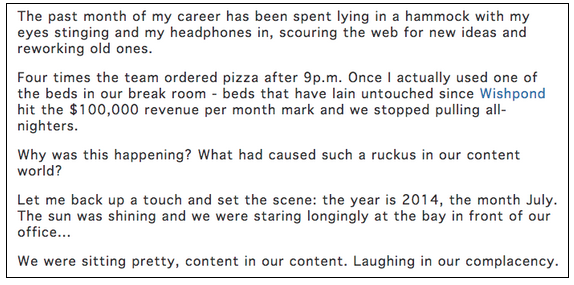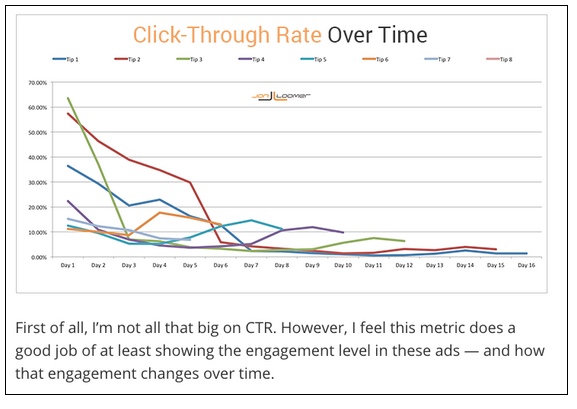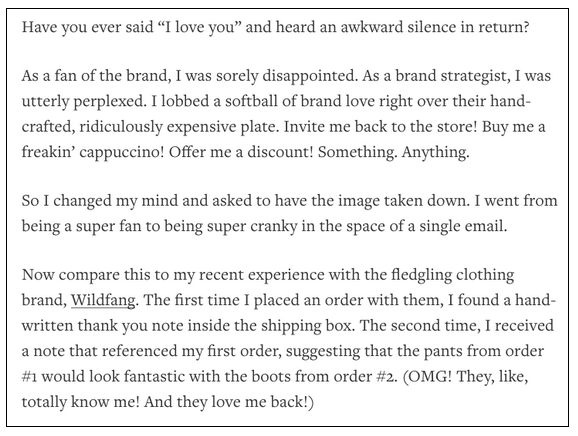I want you to think of the last time you read an article that made a lasting impression. The kind of impression where you actively subscribed to their the blog, checked back regularly for new posts and actually opened and clicked-through on the links in the daily emails they send out.
Doesn’t happen a lot, does it?
I don’t think this is any fault of the writer per-se, as I can guarantee that everyone that breathes the air has a personality in there somewhere.
I think the problem comes down to the fact that they haven’t thought particularly hard about putting their own unique and amazing personality into their content.
They (if they’re anything like me when I first started writing) simply thought, “If I make words on the screen and hit publish then I’ll find success.”
After the first few times I posted and only a handful of people shared my article (mostly my relatives) and I got no comments I changed my train of thought to: ”Oh shit, this isn’t as easy as it looks.”
If you want to see the first article I ever posted at Wishpond here’s the link: Social Media Marketing for Hotels and Resorts: 10 Tips. I’m sharing this with you because, although I’m slightly embarrassed, it’s something that will hopefully be a learning moment now for you (and a cathartic one for me).

Despite the fact that everything in that article is bang on, accurate, and educational, those things don’t make up for the fact that it’s incredibly boring.
In this article I’m going to, with as much of my own content personality as possible, help you figure out your own – thereby increasing your social shares, comments, and blog subscriber list. At the very least I’m going to give you some actionable strategies to make sure you don’t sound like a content robot.
Let’s dive in. Cannonball!
Step one: Think about the audience you’re trying to appeal to
“Writing content for everyone results in content written for no one.”
You need to write for an identified audience. This audience could be stay-at-home mom’s, marketers, teens, what have you, but if you try to write for everyone it’s going to distill your message and result in poor-quality subscribers and leads.
My audience is composed of people like myself – marketing nerds. As I write I think “would I enjoy reading this?” If the answer is no, it’s either back to the drawing board to try again or a heavy edit.
There’s no one set way to establish your audience but here are four things I recommend thinking about:
Ask your customer support staff: These people have one-on-one conversations with your customers all of the time. This means that they’ll have a better idea of who they are and what they want.
Check your social media: You’re already sharing content. Which posts are getting favorited, liked, shared and retweeted? Which links are getting clicked on? A quick stroll to your analytics page will give you a ton of insight into the type of the people who make up your audience. You can also head to “ Audience Insights” on Facebook to get a good snapshot.
Read the comments on articles from similar businesses: Let’s say that you have an online yoga apparel store. I’d recommend popping on the blog of a couple yoga studios, healthy living blogs and Lululemon. You’d be able to figure out what their target audience is and tweak it to your own style.
Create a buyer persona: What do most big businesses have in common? They’ve created fictional personas that they use when they’re writing outgoing communication. A buyer persona is like a passport to your audience. You’ll include the characteristics of your ideal customer – things like character traits, demographics, even a picture. Think of this as a snapshot of who you’re writing for.
Step two: Pick a tone
Now that you’ve established who you’re writing for, you need to figure out how you want to talk to them. This is your tone. Just like you don’t want to listen to metal if you’re into soft-rock, you don’t want to be too formal for an audience that wants casual.
What does tone look like?
Look at the following images – what kind of tone do you think these people (or puppies) are portraying in each photo?

Okay, so you’re probably thinking, “Samantha, it’s far easier to establish tone in real life than it is through a computer screen”. This is true. In person, your tone will be established in your expression, your voice and in the way you dress. The thing is, it can be just as easy to establish a tone in what you say.
Here are some examples of what I mean:
- Formal – “To whom it may concern”
- Informal – “Hey guys”
- Intimate – “You, like me, have probably experienced the frustration of…”
- Playful – “Did you just click our subscribe button? – Get ready for some fun!”
- Serious – “We apologize for the error you received and are rectifying it as we speak. Expect an update from us in the next 10 to 15 minutes.”
- Sarcastic – “If you haven’t been hiding under a rock for the past year…”
- Etc. etc. etc.
To give you some further inspiration check out Buffer’s tone guide.
Step three: Establish your personality
Once you’ve figured out the way you want your writing to come across you need to take a deep look inside – who are you and how do you want people to view you and your content?
The thing is, you can’t really change the personality you have, but you can use it to your advantage.
Think about all the different personality types there are. Although technically there are 16 defined personality types there’s a lot of variety between them.
Here’s a little overview of the primary personality groups:
“Analysts”: These are those results-driven people who get a kick out of seeing how their plans have turned out.
“Diplomats”: They’re the people who are easily inspired, and look to inspire others. They’re not only creative in their thought process but also in their originality and approach to life.
“Sentinels”: Although less imaginative, they’re super practical and you can always count on them to get things done. They’re dedicated, hard-working, and loyal.
“Explorers”: These are those people that are always looking for the truths. They’re spontaneous, energetic and ready to become the masters of their own destiny.
Aside from just being really cool to know about, I listed these personality types for a reason: for you to determine where you fit.
If you’re really into numbers, be that person who creates graphs, images and benchmark reports. If you’re a diplomat, write on those topics that everyone has heard of but do it in a way that no one has ever thought of. Sentinels are the best because they get all of that mundane work done that I don’t want to as a diplomat.
Now that I’ve given you lots to think about, I’m going to let you in on a secret (that isn’t really a secret) but has been a huge influence on my own content creation…
Step four: Look for inspiration from other writers
You’ve made it to step four, ‘woo hoo!’ You’re well on your way to creating content that rocks all of the socks off. But there’s one more step that I implore you to take.
Read content that you enjoy. Simple huh?
People are already writing amazing content all around you. So get inspired by it.
By taking the initiative and seeing what grooves with your style you’ll become a more sincere and valuable writer.
I’ve compiled four personalities that you might recognize:
- The Shakespeare
- The Hard sell
- The Analyst
- The Quirk
Type one: The Shakespeare (AKA English Major)
This is the person who, no matter how many times you tell them to KISS (Keep It Simple Stupid) is insistent on using parallel syntax. Which, in case you didn’t know, is: “repetition among adjacent sentences or clauses. The repeated sentences or clauses provides emphasis to a center theme or idea the author is trying to convey.”
This type of writer is clever, witty and uses words to help visualize the content through story. Personally, as I read this excerpt I could imagine myself lying in that hammock right next to James Scherer (Wishpond’s resident Shakespeare):

Who uses this?
- Brian Clark (Copy Blogger)
- Robert Rose (Content Marketing Institute)
- James Scherer (Wishpond)
Type two: The Hard Sell (AKA Salesperson)
This is more of a go big or go home approach. Instead of getting you stoked through their words they’re getting you excited through incentive.
They do this by making you believe that you can achieve the same results they have if you follow the same steps: “I did this really amazing thing, it was easy and you can do it to.”

Who uses this?
- Jeremy Shoemaker
- Neil Patel
Type three: The Analyst
There’s been a substantial amount of growth in the amount of transparency we’re seeing in content and a form of personality that a lot of businesses are tapping into. Similar to the “Hard Sell” personality, they’re showing off their results and chances are, it’s mostly positive.
The thing is they’re not doing it in a salesy way. They’re doing in a way that shows how you can track your results, things you can try to potentially find success and how to learn from your failures.

Who uses this?
- Jon Loomer
- Alex Turnbull
Type four: The Quirk
Like the Shakespeare, this person also tells a story but takes a different approach. They’re there to make you laugh, make you cry and then hit the point home at the end.
There’s an immense amount of buildup, getting you to visualize what’s going on in your head before diving into the lessons. Look at the beginning of this article if you want another example. Instead of diving straight into what I was going to be talking about, I gave you my life story well, my story of writing content.

Who uses this?
- Kimberly Crossland
- Jen Maer
- Samantha Mykyte
Conclusion
The thing about personality and tone is that the options to show off ‘you’ and ‘your business’ are limitless. It doesn’t have to be cut and dry, you can pick parts of personalities you like and scrap others.
The main point that I’d like you to take away from this article is that it’s all about finding who you are. Once you own the personality that is ‘you,’ you’ll be able to deliver content that gets people engaged.
What kind of content personality do you have? How has it affected your business and content? I’d love to hear about some of your examples!
– Written by Samantha Mykyte
When Samantha isn’t crushing content at Wishpond she performs with her burlesque troupe, casts spells in dungeons and dragons and enjoys hitting the slopes.
